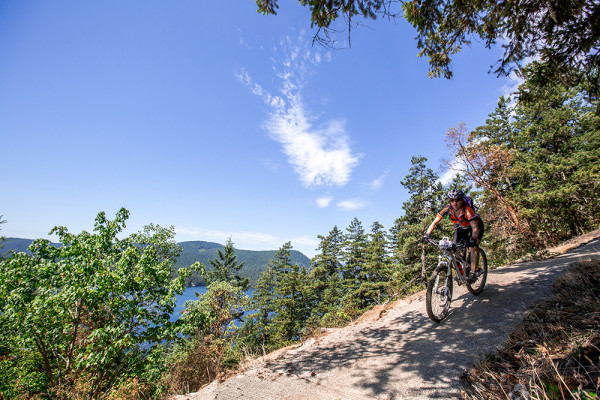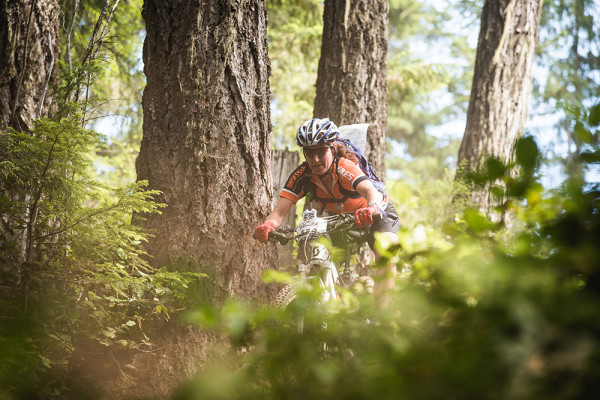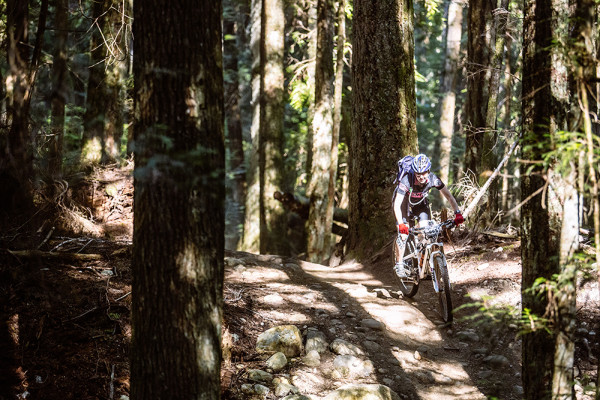– Words by Teresa Edgar –
Karley Cunningham is no stranger to racing. She had first started racing in the Ontario Cup Circuit back in 2000, two years after she had learned how to mountain bike. Within another two years she had moved up the ranks to become a member of the Fly Gurlz, Canada’s national-level women’s mountain bike race team. The team disbanded in 2009.
She originally raced the BC Bike Race in 2008, although that year the race didn’t go well for her. As Cunningham puts it, “I had a terrible time the first time I did [the] BCBR — wrong teammate, wrong training, wrong nutrition, wrong bike. I could go on with the ‘wrong’ list, but you get the picture. It really made for a dreadful week.”

Her list of wrongs took their toll. “After Day 3, I remember being so exhausted and beaten up that I sat on the curb and cried because I just didn’t know if I could physically keep on going,” said Cunningham.
Back then the BC Bike Race was a point-to-point race with much of the route following logging roads between the communities; and the singletrack didn’t start until near the end of the ride, which made the days seem longer to Cunningham. Partners were also mandatory in 2008. “There is a whole additional complicated layer to having a partner”, Cunningham recalled. “If you haven’t ridden together to the point of bonking, pure frustration, hitting the wall, and if you aren’t careful to work out your communication, specific needs, etc. you can set yourself up for some big surprises race week.”
With such a challenging time on her first try, I asked Cunningham what made her decide to race the BC Bike Race again, “It was time to rewrite the story,” she said, “and this time definitely make it my best week on a bike!”
Cunningham took her list of wrongs and made them a learning experience. “This time I made the decision early on to ‘train by science’, which I was super stoked about because I wanted to see what I could do by using the data and the science and ‘doing the right things’.” The data she used was from a lactate threshold test, which helped to establish her training zones.
Cunningham’s wife Elise had formerly worked as an exercise physiologist and was able to design a base building program, which she started in the fall. In January, Cunningham started to work with a coach and continued to take lactate threshold tests throughout her training to measure her improvements. The test results also helped her coach tweak her training plan.
The race format for the BC Bike Race had changed since the last time Cunningham participated. Instead of being a point-to-point race, the BC Bike Race now focused on the best singletrack in each location. “The reason we moved away from the point-to-point was based on Jeremy Grasby who kept pushing us to come to Cumberland for a whole day of good trails and not ride there on gravel roads to just taste the singletrack – we credit mostly Jeremy with this push,” says Andreas Hestler, Marketing Director and one of the founders of the BC Bike Race.
And partners are no longer mandatory. Hestler explains, “In the beginning we did more backcountry and we mandated teams for safety and because it was the industry standard – then along the way, about 2009 or 2010, we realized that the nature of the singletrack made it harder for teams to stay together and started to open the individual category. It was also as we moved to more ‘front country’ race tracks that the team safety became a moot point – we were no longer in the ‘backcountry’.”

Cunningham had decided to register as a solo rider for the 2015 BC Bike Race, “In my training for [the] BCBR, while I had some awesome training partners, I found that I really like my own company. I was a little worried that I would be out on the course all by myself and lonely since I’m not a fast rider, but I was surrounded by the same people each day that rode the same speed. We chatted, supported each other, checked on each other and cheered each other on. It was really fun!”
This year, the BC Bike Race presented a new challenge for Cunningham. It was one of the hottest years for the race, temperatures soared upwards of 32 degrees Celsius, and the heat affected several racers. Cunningham found herself teaming up with other riders for moral support on Day 1 in Cumberland. “I knew what was coming having pre-ridden the course, but still the heat beat me down pretty bad. Riders were dropping like flies and Matt Morrish and I made it through by encouraging [another] small group of…riders through to the second aid station who were also suffering.
“Despite that fact that we were both hurting, hot and tired, we somehow managed to hoot and holler our way through the last half of the Cumberland course. I can’t remember the last time I had that much fun with a total stranger!”
On Day 5, I waited for Cunningham at the top of Expresso in the Rocky Mountain Bicycles’ cheer zone in North Vancouver. It’s one of the shorter stages of the 2015 BC Bike Race — 39 kilometres with an elevation gain of 1,525 metres — and based on her times for the previous stages, I had a good idea of when to expect her to arrive. I also knew who else was close to her in the pack so I watched for them to predict when she should be getting close. When I saw the riders she had been riding with, but still no sign of Cunningham, I started to get concerned. Did the heat get to her or did she have a mechanical?
It wasn’t much longer before I saw her crest the hill where we’re gathered. Cunningham is a Vancouver resident, and although the North Vancouver trails were her training ground, that didn’t necessarily give her an advantage. She had taken a wrong turn earlier in the day. Instead of following the pink flagging tape, Cunningham had gone into autopilot and started riding the route she had used for her training; which cost her a few minutes when she realized she was off-course and had to backtrack. Despite her mistake, Cunningham was still in good spirits. She was tired, but she knew she was on the home stretch for the stage as she started to make her way down Expresso.
I caught up with Cunningham on course again on Day 6 in Squamish and she was still doing well, although the heat had started to catch up with her. The official temperature was 25C but it felt much hotter; she watched her hydration and electrolyte intake and paced herself so she didn’t overheat. As the week went on, Cunningham found that it took longer for her body to recover at the end of the day, and the temperature on course wasn’t helping.
When I see Cunningham again, the race is over and she’s proudly wearing her BC Bike Race finisher’s t-shirt; she’s also happy to have completed the week without any major mechanicals or injuries. We relax in the shade by the Olympic Rings in Whistler and talk about the differences between her two BC Bike Race experiences.
“This time was still the one of the biggest physical challenges I’ve ever faced. No question each course is physically demanding in its own way. But this time I got to the start line of each day feeling recovered and surprisingly fresh. Okay, maybe not Day 7 (laughs) but to be expected.”
Cunningham credits her training with the more positive experience she had this year, “The change was the training and overall prep that I did. Last time I hacked my training together from what I knew when I was racing pro-Elite ‘back in the day’.”

While the more formal training plan definitely helped to improve her overall experience, when I asked what her favourite memories from the week were Cunningham responds, “Hands down the PEOPLE! So many amazing people from all over the world, who participate and volunteer; [and] walking off the ferry in Powell River to a hero’s welcome. The residents of Powell River were really amazing…so many locals there ringing cowbells and cheering to welcome us – there’s been few times where I’ve felt that special and welcomed in my life, it actually brought tears to my eyes.”

